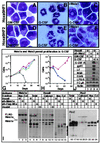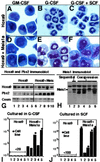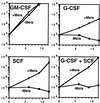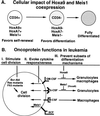Meis1a suppresses differentiation by G-CSF and promotes proliferation by SCF: potential mechanisms of cooperativity with Hoxa9 in myeloid leukemia
- PMID: 11687616
- PMCID: PMC60834
- DOI: 10.1073/pnas.231115398
Meis1a suppresses differentiation by G-CSF and promotes proliferation by SCF: potential mechanisms of cooperativity with Hoxa9 in myeloid leukemia
Abstract
Hoxa9 and Meis1a are homeodomain transcription factors that heterodimerize on DNA and are down-regulated during normal myeloid differentiation. Hoxa9 and Meis1a cooperate to induce acute myeloid leukemia (AML) in mice, and are coexpressed in human AML. Despite their cooperativity in leukemogenesis, we demonstrated previously that retroviral expression of Hoxa9 alone--in the absence of coexpressed retroviral Meis1 or of expression of endogenous Meis genes--blocks neutrophil and macrophage differentiation of primary myeloid progenitors cultured in granulocyte-macrophage colony-stimulating factor (GM-CSF). Expression of Meis1 alone did not immortalize any factor-dependent marrow progenitor. Because HoxA9-immortalized progenitors still execute granulocytic differentiation in response to granulocyte CSF (G-CSF) and monocyte differentiation in response to macrophage CSF (M-CSF), we tested the possibility that Meis1a cooperates with Hoxa9 by blocking viable differentiation pathways unaffected by Hoxa9 alone. Here we report that Meis1a suppresses G-CSF-induced granulocytic differentiation of Hoxa9-immortalized progenitors, permitting indefinite self-renewal in G-CSF. Meis1a also reprograms Hoxa9-immortalized progenitors to proliferate, rather than die, in response to stem cell factor (SCF) alone. We propose that Meis1a and Hoxa9 are part of a molecular switch that regulates progenitor abundance by suppressing differentiation and maintaining self-renewal in response to different subsets of cytokines during myelopoiesis. The independent differentiation pathways targeted by Hoxa9 and Meis1a prompt a "cooperative differentiation arrest" hypothesis for a subset of leukemia, in which cooperating transcription factor oncoproteins block complementary subsets of differentiation pathways, establishing a more complete differentiation block in vivo.
Figures





Similar articles
-
Nup98-HoxA9 immortalizes myeloid progenitors, enforces expression of Hoxa9, Hoxa7 and Meis1, and alters cytokine-specific responses in a manner similar to that induced by retroviral co-expression of Hoxa9 and Meis1.Oncogene. 2002 Jun 20;21(27):4247-56. doi: 10.1038/sj.onc.1205516. Oncogene. 2002. PMID: 12082612
-
Hoxa9 immortalizes a granulocyte-macrophage colony-stimulating factor-dependent promyelocyte capable of biphenotypic differentiation to neutrophils or macrophages, independent of enforced meis expression.Mol Cell Biol. 2000 May;20(9):3274-85. doi: 10.1128/MCB.20.9.3274-3285.2000. Mol Cell Biol. 2000. PMID: 10757811 Free PMC article.
-
Persistent transactivation by meis1 replaces hox function in myeloid leukemogenesis models: evidence for co-occupancy of meis1-pbx and hox-pbx complexes on promoters of leukemia-associated genes.Mol Cell Biol. 2006 May;26(10):3902-16. doi: 10.1128/MCB.26.10.3902-3916.2006. Mol Cell Biol. 2006. PMID: 16648484 Free PMC article.
-
Expression of FLT3 receptor and response to FLT3 ligand by leukemic cells.Leukemia. 1996 Apr;10(4):588-99. Leukemia. 1996. PMID: 8618433 Review.
-
Estrogen-regulated conditional oncoproteins: tools to address open questions in normal myeloid cell function, normal myeloid differentiation, and the genetic basis of differentiation arrest in myeloid leukemia.Leuk Lymphoma. 2003 Jul;44(7):1131-9. doi: 10.1080/1042819031000063444. Leuk Lymphoma. 2003. PMID: 12916864 Review.
Cited by
-
Protein kinase C-mediated phosphorylation of the leukemia-associated HOXA9 protein impairs its DNA binding ability and induces myeloid differentiation.Mol Cell Biol. 2004 May;24(9):3827-37. doi: 10.1128/MCB.24.9.3827-3837.2004. Mol Cell Biol. 2004. PMID: 15082777 Free PMC article.
-
Thrombopoietin induces HOXA9 nuclear transport in immature hematopoietic cells: potential mechanism by which the hormone favorably affects hematopoietic stem cells.Mol Cell Biol. 2004 Aug;24(15):6751-62. doi: 10.1128/MCB.24.15.6751-6762.2004. Mol Cell Biol. 2004. PMID: 15254242 Free PMC article.
-
Characterization of Leukemia-Inducing Genes Using a Proto-Oncogene/Homeobox Gene Retroviral Human cDNA Library in a Mouse In Vivo Model.PLoS One. 2015 Nov 25;10(11):e0143240. doi: 10.1371/journal.pone.0143240. eCollection 2015. PLoS One. 2015. PMID: 26606454 Free PMC article.
-
Dual actions of Meis1 inhibit erythroid progenitor development and sustain general hematopoietic cell proliferation.Blood. 2012 Jul 12;120(2):335-46. doi: 10.1182/blood-2012-01-403139. Epub 2012 Jun 4. Blood. 2012. PMID: 22665933 Free PMC article.
-
Meis1 programs transcription of FLT3 and cancer stem cell character, using a mechanism that requires interaction with Pbx and a novel function of the Meis1 C-terminus.Blood. 2005 Jul 1;106(1):254-64. doi: 10.1182/blood-2004-12-4664. Epub 2005 Mar 8. Blood. 2005. PMID: 15755900 Free PMC article.
References
-
- Look A T. Science. 1997;278:1059–1064. - PubMed
-
- Nakamura T, Jenkins N A, Copeland N G. Oncogene. 1996;13:2235–2242. - PubMed
-
- Nakamura T, Largaespada D A, Shaughnessy J D, Jenkins N A, Copeland N G. Nat Genet. 1996;12:149–153. - PubMed
-
- Steelman S, Moskow J J, Muzynski K, North C, Druck T, Montgomery J C, Huebner K, Daar I O, Buchberg A M. Genome Res. 1997;7:142–156. - PubMed
Publication types
MeSH terms
Substances
Grants and funding
LinkOut - more resources
Full Text Sources
Other Literature Sources
Research Materials

